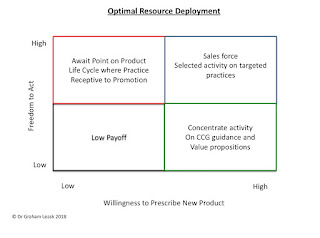What really influences uptake curves and how to operationalise this by Dr Graham Leask.
This is an interesting question that can be addressed in a variety of ways. At an individual unit level i.e. Practice each individual’s decision to use a new product is initially influenced by three main processes. Firstly, evaluation that relates to the individual being aware of the product and interested enough to try it. Secondly, adoption whereby the customer has weighed the clinical evidence together with their own limited patient trial and decided to add the product to their armamentarium – the selected list of drugs that they use to treat a particular condition. Finally, contagion whereby their enthusiasm and the comments of their peers interact to influence the received practice view or those of their colleagues. How do we operationalise this – in short by garnering the right clinical evidence then marshalling and presenting a compelling case but what is of interest to one individual may not interest another at that particular time. In operational terms this means effective targeting where most companies rely on time worn out of date methods involving Pareto and Vinciles – Who was Vince anyway it’s so long back in my memory I can’t quite remember. Modern targeting involves the use of highly effective mathematical models that place each Surgery or Hospital Department in order of adoption along Everett’s Diffusion Curve. As a first step we target those individuals most likely to adopt first thus maximizing our initial uptake trajectory. This decision cannot however be divorced from their environment. See below diagram.
What this means in practice is that some Health Authoritities may effectively be largely ignored until their point of the adoption cycle is reached in our promotional plan. In particular the degree of freedom afforded to practices within a given health authority will strongly influence their enthusiasm to adopt new products and it is important to factor in this degree of control when planning our promotion.
This modern approach to targeting allows us to diary forward our promotional campaign so that we concentrate effort on those practices and departments that are most likely to respond positively. This has two immediate advantages it shakes our field team out of their comfort zone by directing activity on to practices and individuals that they may not have called upon before, thus expanding “effective coverage”. Secondly by focusing coverage on those most likely to prescribe we can manage our resources more effectively with less wastage. Effective coverage in this instance meaning that cohort of customers most likely to prescribe at this point in the product life cycle.
Finally, we should focus our resources more carefully. There is a common practice within some companies to concentrate more on spending our budget than on parsimoniously managing our resources. Not only is this wasteful in monetary terms, it is both hazardous and wasteful in customer terms. I was once told by one head of Digital at a conference that digital is highly effective because it is so inexpensive ! Nothing could be further from the truth. Access to customers is our most critical resource and we must guard it carefully. Viewed in this regard some digital content can be viewed as counterproductive as it may in effect lessen the opportunity for a representative call. There is also strong evidence that some digital elements may be ineffective or obfuscate the presentation of a clear compelling argument.
Recent evidence from an in-depth detailed study of promotion found that Email contacts had no effect whatsoever on prescribing. This however can’t come as a shock to us as how many of us actually read and act on all the emails we receive. Most go in to our junk box that we regularly discard. What did prove highly effective were Webex calls – but primarily when these were used as a follow up to a previous face to face call or group detail contact. This in turn brings me back to my first point the key to optimal sales performance is the right message delivered to the right customer at the right time – in effect effective targeting. Not targeting as we know it however but sophisticated precision targeting based on modern sophisticated mathematical models that rank customers in order of their willingness to prescribe, the accessibility of the practice and their freedom to act.


Comments
Post a Comment